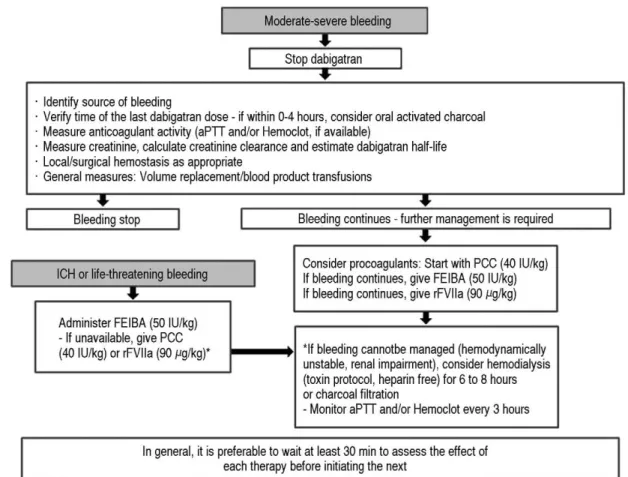증 증 례례
Introduction
Warfarin remains the standard anticoagulant for
ischemic stroke prevention in patients with atrial fib- rillation, deep vein thrombosis and pulmonary thromboembolism. Because the anticoagulant effects of warfarin vary from individual to individual, opti- mizing warfarin dosage in individual patients can be difficult
1). Dabigatran is the first oral direct thrombin inhibitor approved by the US Food and Drug Administration (FDA) for the prevention of stroke and systemic embolism in patients with non-valvular atrial fibrillation
2). Because the anticoagulant effects of dabi- gatran are more predictable than those of warfarin,
급성신손상으로 인해 발생한 dabigatran 독성
동국대학교 의과대학 동국대학교 일산병원 내과학교실
문형호∙이승은∙오동준∙조희범∙권기환∙김윤진∙김경수∙신성준
Dabigatran Toxicity Secondary to Acute Kidney Injury
Hyoung Ho Moon, M.D., Seung Eun Lee, M.D., Dong Jun Oh, M.D., Hee Bum Jo, M.D., Ki Hwan Kwon, M.D.
1, Yoon Jin Kim, M.D., Kyung Soo Kim, M.D., Sung Joon Shin, M.D.
Department of Internal Medicine, Dongguk University Ilsan Hospital, Dongguk University College of Medicine, Go-yang, Korea
Dabigatran is the first oral direct thrombin inhibitor approved by the US Food and Drug Administration (FDA) for pre- vention of stroke and systemic embolism in patients with nonvalvular atrial fibrillation. Because dabigatran is excret- ed mainly by the kidneys, serum levels of dabigatran can be elevated to a supratherapeutic range in patients with renal failure, predisposing to emergent bleeding. We describe the case of a 66-year-old man taking dabigatran 150 mg twice daily for atrial fibrillation and cerebral infarction who presented with hematochezia and disseminated intravascular coagulation. Laboratory evaluation showed a hemoglobin level of 6.3 g/dL, platelets of 138,000/mm
3, activated partial thromboplastin time (aPTT) of 10?s, and an international normalized ratio (INR) of 8.17.
Colonoscopy showed a bleeding anal fissure. Hemostasis was provided by hemoclips and packed red blood cells and fresh frozen plasma were transfused. Since then, there was no further hematochezia, however, bleeding includ- ing oral mucosal bleeding, hematuria, and intravenous site bleeding persisted. At presentation, his serum creatinine was 4.96 mg/dL (baseline creatinine, 0.9 mg/dL). Dabigatran toxicity secondary to acute kidney injury was pre- sumed. Because acute kidney injury of unknown cause was progressing after admission, he was treated with hemodialysis. Fresh frozen plasma transfusion was provided with hemodialysis. At 15 days from admission, there was no further bleeding, and laboratory values, including hemoglobin, partial thromboplastin time, and prothrombin time were normalized. He was discharged without bleeding. After 2 months, he undergoes dialysis three times per week and no recurrence of bleeding has been observed.
Key Words: Dabigatran, Acute kidney injury, Disseminated intravascular coagulation, Hemodialysis
책임저자: 신 성 준
경기도 고양시 일산동구 동국로 27 동국대학교 일산병원 내과학교실 Tel: 031) 961-7145, Fax: 031) 961-7153 E-mail: shine@duih.org
투고일: 2014년 7월 3일 1차 심사일: 2014년 7월 4일 게재 승인일: 2014년 8월 7일
